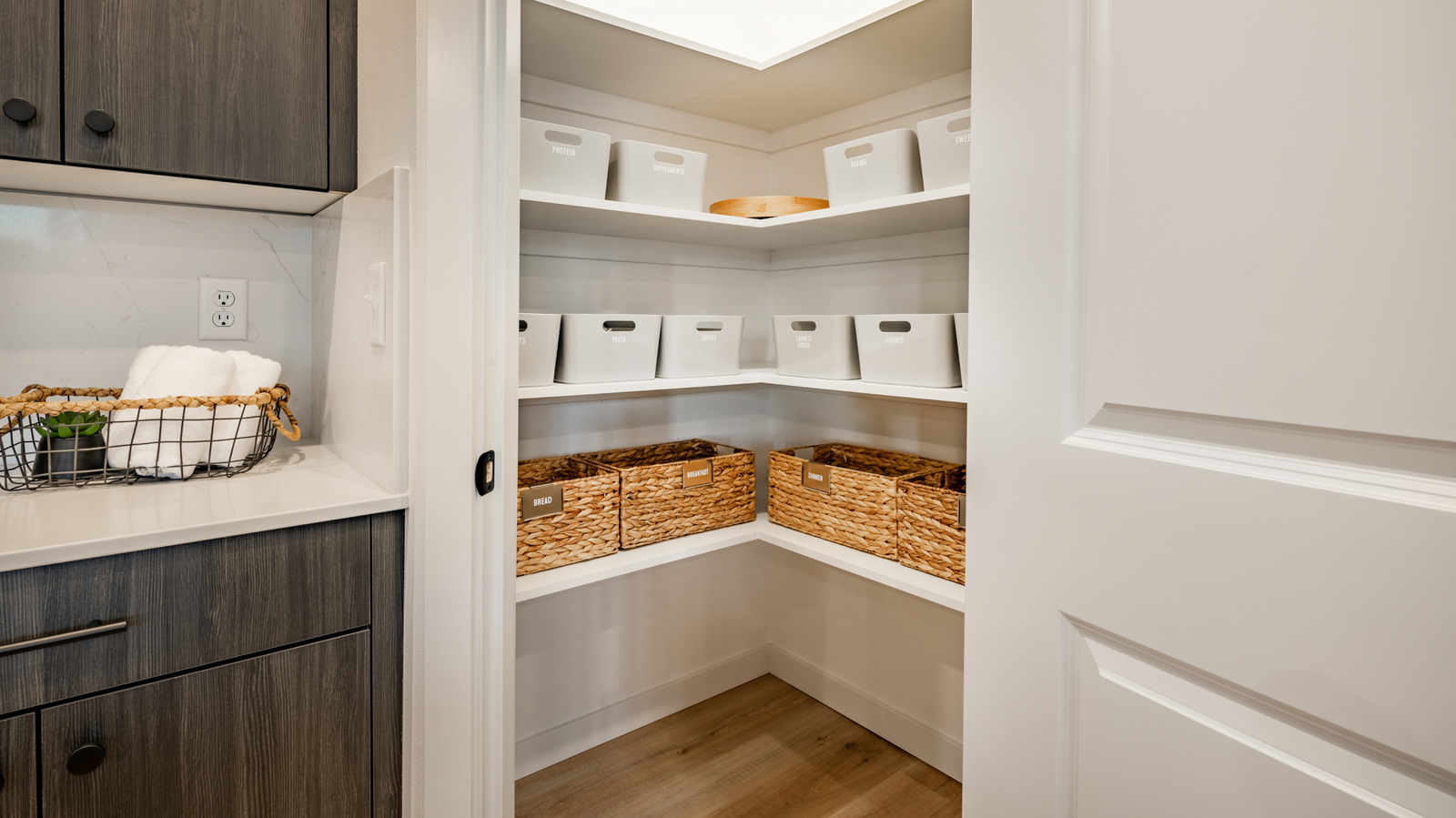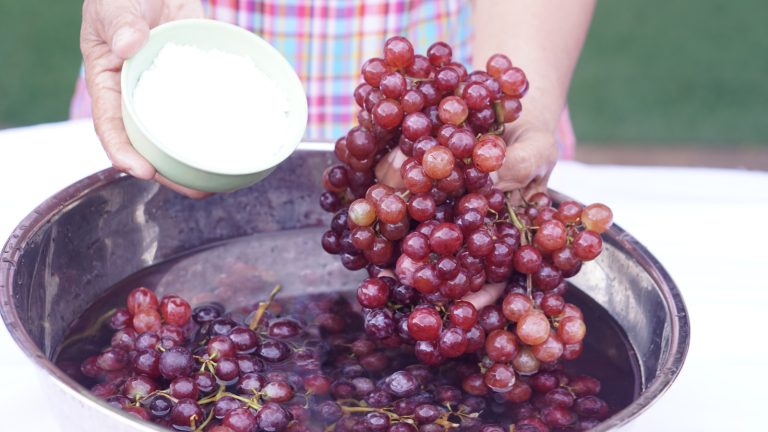There’s been a rise in innovative pantry renovations over the past few years, and it’s been exciting to see just how much can be done with this particular space. Gone are the days of simply stocking your shelves with dry goods and doing an annual scan of expiration dates to free up some space. Now it’s all about creating a beautiful and functional part of your kitchen that can both increase your productivity and decrease food waste.
Kitchen renovations and design advice often focuses on the aesthetic elements, as well as the big ticket items like appliances and light fixtures. These, of course, are all important aspects of a beautiful kitchen, but we’d argue that the pantry deserves just as much attention and consideration. This zone might be less visible than your kitchen island, but a great pantry can boost a kitchen’s design in a whole new way.
With this in mind, we’ve rounded up some great ways to renovate your pantry, whether you’re blessed with a sprawling walk-in or you’re dealing with a discrete closet tucked into the corner.
1. Implement a cohesive storage system
No matter the size of your pantry space, a cohesive storage system is an absolute must. Professional organizers are divided on whether decanting your dry goods is useful, but we can’t argue that it does breathe new life into the storage area.
But whether you decant or not, storage bins and baskets are great in this kitchen closet. Just remember that one of the worst mistakes you can make when organizing your pantry is using the wrong type of containers. You want to get stackable pieces that can fit tightly together on the shelf so that no space is wasted. On top of that, it’s best to avoid round containers because they are one of the worst ways to organize a pantry. And if you’re not using clear storage containers, then be sure to label things.
Whatever you do, remember that the best storage systems can be used and maintained by everyone in your home. If the rest of your household can’t navigate the system and the responsibility of keeping tabs on the shelves falls on one person, then some tweaks might be in order. Once the details are sorted, then the functionality of your pantry should only improve.
2. Create an appliance garage
For anyone who hasn’t heard this term before, appliance garages are a rising trend where small appliances are tucked away in an accessible cabinet or closet. Some versions even feature outlets and countertops inside the pantry so the appliances can stay put in the “garage,” while others are simply dedicated storage zones.
Either way, the benefit to the rest of the kitchen is the same. With small appliances stored away, counter space is freed up for use — and depending on the room available in your pantry, you might already have room for an appliance garage in your life. Start by fully decluttering the area, and consider implementing a storage system. Once this is done, assess which shelf would be best for your appliances. The goal is ease, so you should avoid keeping them too high up or in a spot that makes them difficult to lift.
If you have a larger pantry or are planning a bigger renovation, consider adding outlets and worktops to fully convert your pantry into a shared appliance garage.
3. Design a lighting plan
A well-designed and layered lighting plan can make or break any room in terms of ambiance, but many people underestimate the power in the spaces that aren’t as visible. This includes places like closets, cabinets, and, yes, pantries.
If you want your pantry space to pack a punch, consider incorporating more lighting into this area of your kitchen. If you’re undertaking a full renovation, this might require a more involved installation. You could add a flush or semi-flush fixture to the ceiling, shelf lighting, and even uplights if you have a walk-in. But if you’re looking for a DIY solution, you can get creative with self-adhesive strips and puck lights.
Of course, the goal in a pantry is going to be more about function than ambiance, but with some layered lighting, you can easily improve an area that often falls to the wayside when creating a kitchen electrical plan.
4. Pick a paint palette
Since pantries are often closed-off spaces in kitchens and aren’t typically thought of as the focal point of the room, you might not have considered painting this particular cupboard. But this can actually be a great, easy, and affordable way to elevate your pantry.
Selecting the perfect paint colors for your kitchen might sound intimidating, but once you have the palette all sorted out, extend the colors into your pantry. You could either opt to paint the exterior door a similar color to your cabinetry, or keep it neutral to the wall so that it blends seamlessly. And when it’s time to paint the inside, why not have some fun? Choose an eye-catching color for the walls, paint the shelves a different color, or even play around with wallpaper and shelf liners. Your approach might depend on your pantry layout, location, and size, but don’t shy away from adding a pop of color.
5. Start taking inventory
One of the best ways to make the most of your pantry is by keeping a more regular inventory of what you actually have on your shelves. This doesn’t have to be a dry and boring task. Instead, you could even incorporate a shared system into your pantry’s design.
Along with labeling any storage systems you decide to implement into the space, you can also use the interior side of the door or any walls to hang a chalkboard, white board, or even a virtual assistant to keep tabs on things. Use it to make note of what items are set to expire soon, share meal plans, or make grocery lists the whole household can help with.
By doing so, you can increase your pantry’s functionality, as well as maximize your food items and, in the long run, reduce waste by ensuring everything you have gets worked into your menu rotation.
6. Make the most of open or glass-front shelves
There are major pros and cons to open shelving in a kitchen. You can use it to create beautiful vignettes that tie your whole kitchen’s design together, or it might be a great excuse to upgrade your dishes since they’re on display. But if your pantry is glass-front or open, this can be a little bit trickier.
Rather than panic that your pantry is constantly on display, make the most of it, because there are some definite silver linings to consider. A fully displayed pantry calls for an innovative approach to organization, for one thing, but it also requires careful planning and attention to detail. Closed-off pantries often become cluttered, partly because everything is “out of sight, out of mind.”
But with open or glass-front shelving, the contents of your pantry are front and center. Instead of letting the cabinets fall into chaos, invest in some great baskets and bins, bust out the label maker, and decant until your heart’s content. Then, work these items into your overall kitchen aesthetic for a well-designed space.
7. Install custom cabinetry and shelving
Many home pantries are basically closets with basic, uniform shelves installed, but if you want to really elevate your pantry, consider opting for a more custom-designed space. Now, while you might picture an especially spacious closet when you hear the phrase “custom-designed pantry,” this can be terrific for smaller pantries too. As a matter of fact, small pantries might benefit even more from a dash of customization.
If shelf space is a problem, consider redesigning your pantry to include shelves that are more useful for your height and depth requirements. Or, if you have a larger pantry, you might find yourself with too many dead zones, or areas of the room that aren’t particularly functional, such as wasted floor space. In this case, adding more cabinetry might be the answer.
Either way, assessing your needs and specific pain points is a great way to come up with a plan that makes sense for your space, and customization is often the path toward finding the best solution for your household.
8. Set up a workstation in the pantry
Depending on the size and style of your pantry, you might not think adding a built-in workstation is at all feasible. However, it might not only be doable, but be a surprisingly easy way to enhance the area. What’s more, it can look different depending on what you need.
In larger kitchens, you can turn your space into more of a second workspace, complete with an additional sink, full countertops, and extra outlets to truly maximize functionality. But even in a smaller pantry, you can create workstations that meet your needs.
Simply think of what it is you’d prefer to do closer to your food storage, whether that’s decanting spices, prepping breakfast, or tackling anything that requires utilizing your smaller appliances. With some creative solutions like pull-out drawers and lowered shelving, you can establish a workspace that will make your main kitchen feel even more spacious.
9. Upgrade your hardware
This might seem more like a superficial aesthetic fix, but upgrading your pantry’s hardware can have plenty of functional benefits, too. Along with swapping out and elevating simple things like the knobs, pulls, and handles on your cabinets and drawers, you can also put in additional matching hardware elements to create storage and organization that didn’t exist before.
One great way to do this is with wall hooks. Installing these in tucked away corners can make the most of vertical space you’re not otherwise using. Hooks are perfect for storing things like reusable shopping bags, extra aprons, and even oven mitts.
Even if you’re only doing it for the aesthetic factor, upgrading your pantry hardware can cause an instant glow-up. This is especially true if you’re working with existing builder-grade fixtures. By swapping these out for something warmer and more functional, you can easily breathe new life into your pantry.
10. Consider using pull-out stations
Making the most of a smaller space isn’t always easy, but it’s also not impossible. If you’re looking at your existing pantry closet or cupboard and wishing you had the space (or the budget) to turn it into the sprawling walk-in of your dreams, don’t despair. There are other things that can be done.
One great way to maximize your pantry space is by using pull-out stations. These function much like drawers and are best installed at counter-height, but they don’t need to simply reveal a large, rectangular storage space. Instead, you can get creative.
Using dividers, you can turn this into spaces perfect for stocking individual snacks — a great hack if you’re dealing with school-aged children who are constantly raiding your pantry but aren’t great at keeping things in order. Or, your pull-out station could reveal a slab of butcher’s block, ideal for food prep and adding more counter space to a tight kitchen. Whatever you decide, the best part is that these can be tucked right back into your pantry without negatively impacting your current layout.
11. Save space with bifold doors
If a standard hinged pantry door swings out into your kitchen and takes up more room than you might like, don’t worry, there are other door options. Bifold doors are a great and visually interesting way to save space in your kitchen. What’s more, they make it easy to access the contents of the pantry.
Rather than opening outward, each bifold door panel folds at the middle, opens up, and slides over to either side of the door. The panels then neatly stay folded open and out of the way. You can feasibly leave the doors open as you work, which means you can avoid constantly opening and closing the cabinet. This is especially handy if you opt to install a work station or convert part of your pantry into an appliance garage. Bifold doors come in a wide range of styles, including but not limited to louver, glass panel, frosted, and shaker.
12. Add a freestanding pantry
Whether you already have an existing pantry and just crave some more cabinetry, or you’re lacking in any functional food storage, consider adding a freestanding pantry. You can place this in your kitchen, mudroom, garage, or even an adjacent alcove.
The thing about a freestanding pantry is that it doesn’t even need to be your primary food storage spot. Instead, this can be a great option if you prefer to store easy backstock for items your family runs through extra quickly. It can also be a low-impact commitment if you think you might want more pantry storage, but you’re not quite sure it’s worth the effort of tackling a full renovation of a built-in closet.
As another added perk, an extra freestanding pantry can also allow you to convert your existing built-in space into something else — whether that’s a more practical workspace, an appliance garage, or converted into custom cabinetry.
13. Lay down an area rug or runner
Plenty of pantries have a strict utilitarian feel, and that’s fine. They’re functional spaces that don’t have to look beautiful to do their job. But if you’re struggling to care about how your pantry works, converting it into a more aesthetically pleasing space might help reinvigorate your interest in maximizing its potential.
Obviously, implementing more storage solutions and adding a lighting plan are paths toward creating a more cohesive pantry, but you can easily add softer touches, too. Most pantries feature wood or stone floors—or possibly cement, if they’re in the basement. These are perfect spaces for throwing down an area rug or runner to help warm up the space. As an added bonus, a rug can also make it easier on your joints, especially if you’re spending a lot of time in this room organizing, unpacking groceries, or even doing some light food prep work.
But even if you have a smaller pantry, a small mat can be a nice addition — much in the way one often looks great at your kitchen sink. Whatever size you need, a rug can help dedicate this area as a specific zone in your kitchen, while adding some extra visual interest.
14. Match your pantry door to the cabinetry
In many homes, the kitchen pantry is designated by a standard white door that looks like the other doors throughout the home. There’s nothing wrong with this, obviously, but perhaps you want your pantry door to feel like it’s part of the cabinetry instead. One great way to blend your pantry in with the rest of your kitchen is by using a door that fits in with the rest of the cabinets. Consider a coat of paint or finish that matches the walls or existing cabinetry. Or, if the pantry is close enough, you could install a new door that is flush with the rest of your kitchen cabinets. This will effectively hide the door, and give your kitchen a finished and upscale look.
Whatever you choose, consider opting for a door that better blends in with the rest of your kitchen. This change can make the space feel all the more seamless and cohesive, which can help with visual flow.
15. Use soft-close drawers and cabinets
If you’re doing a true pantry renovation that involves a full-scale overhaul of your drawers and cabinets, then there’s one functional element that you must be sure to add. Soft-close drawers and cabinets are a bona fide game-changer and a relatively simple way to make your kitchen in general feel more luxe.
Soft-close features aren’t just helpful for preventing the annoying sound of slamming. They can also protect the contents of your cabinets or drawers, as well as your fixtures themselves. After all, less slamming leads to less wear and tear. Plus, if you or anyone you live with is notorious for leaving doors and drawers open, soft-closures make this easier, too. With a gentle nudge, everything tucks back into place, leaving your kitchen looking neater in general.
And as one final added bonus? Soft-close drawers and cabinets are safer, as it’s impossible to slam any fingers in the process of tapping them closed.





